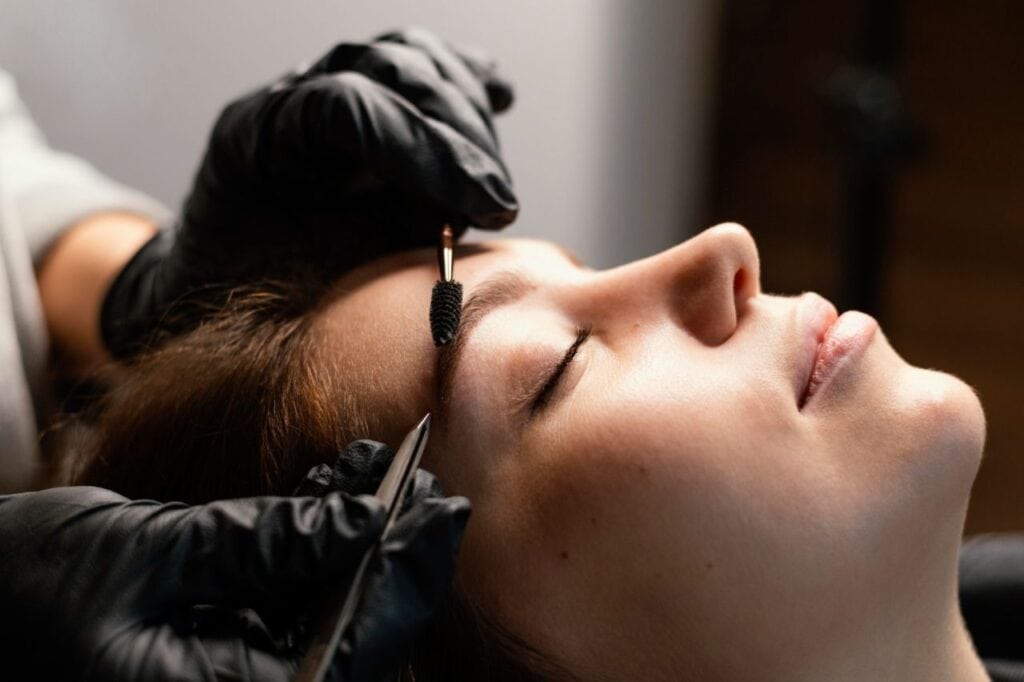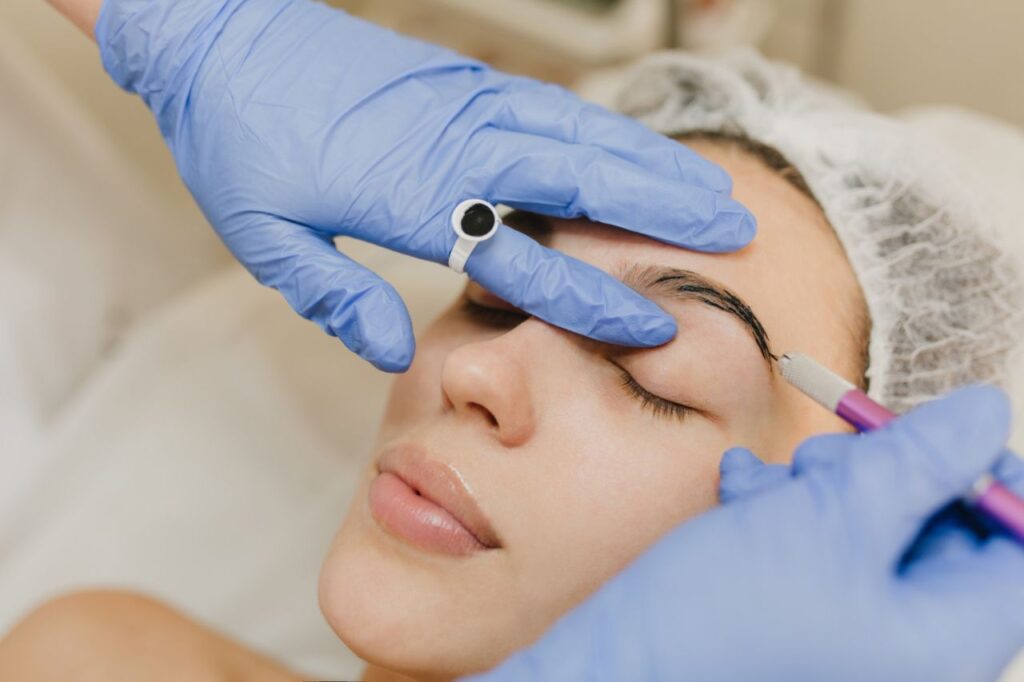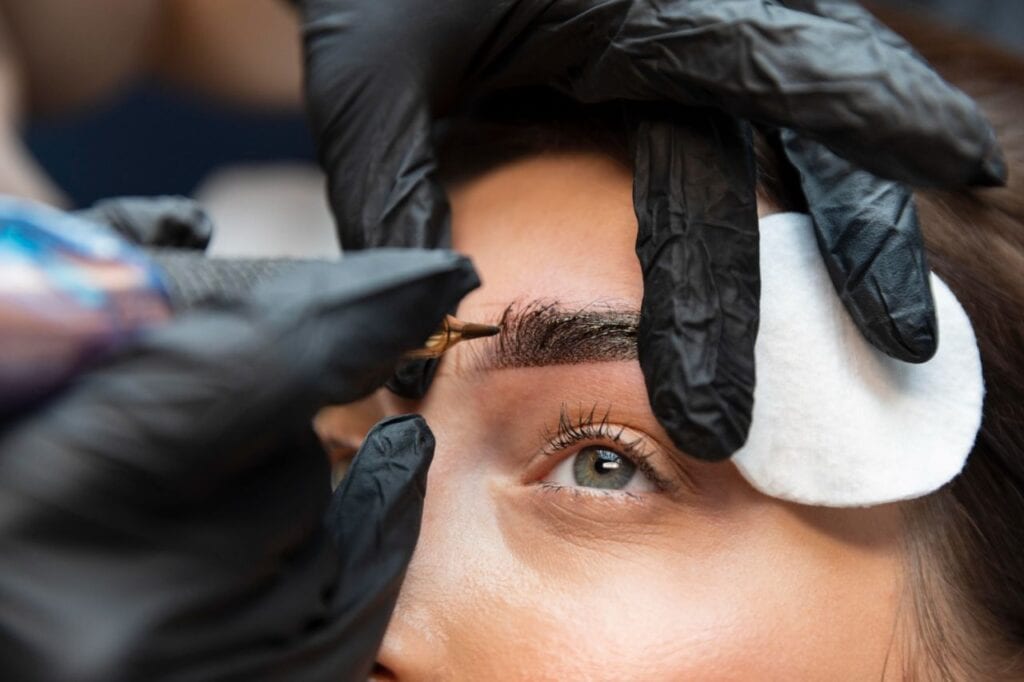In case you're thinking about getting an eyebrow transplant, here's some info you should know.
Eyebrow transplants, in contrast to hair transplants, are a relatively recent operation, and their efficacy is still up for dispute.
It may take time and effort, but you may discover a competent medical professional who can assist you in achieving your goals.
You can drastically alter your face's overall aesthetic with the help of your eyebrows. Some people are born with sparser eyebrow while others have thick eyebrow hair.
Genes can play a part in the appearance and fullness of your brows, so it's important to take care of them. People with sparse eyebrow hair often use cosmetics to make their brows appear thicker and fuller. This phenomenon is more prevalent among females.
However, eyebrows do more than just serve an aesthetic role; they also help to keep moisture, such as drops and sweat, from getting in a person's eyes.
Loss of eyebrow hair can be caused by a few different factors. You could experience eyebrow hair loss if you take certain medications, have certain injuries, have certain medical problems, or even if you take certain vitamins in excess.
Those with sparse or no eyebrow hairs may seek to make a change to their appearance. Eyebrow transplantation is something to think about if you want your brows to look different and fuller than they already do.
In this article, I'll go over the basics of eyebrow transplant surgery, including its preparation, recovery, and any potential complications.
When Did Brow Transplants Start?

The 1990s saw the development of new, more refined techniques for hair transplantation, which paved the way for the possibility of eyebrow transplantation. Although eyebrow hair transplantation has been conducted for over 20 years, it has only lately gained popularity thanks to the contemporary trend of having fuller-looking brows.
What Are Eyebrow Transplants?
Permanent and surgical, an eyebrow transplant is similar to a regular hair transplant in that it involves harvesting hair from a donor site (the back of the head in this case) and replanting it in a new location.
An eyebrow transplant is a surgical procedure in which a graft of hair is removed from another area of the head and transplanted into the eyebrow (plug). In order to restore fullness to the eyebrows, the surgeon transplants a graft containing hair and its follicle to the appropriate place. The donor region for a hair graft is typically the back of the head or the ear.
An ice-cold saline solution is used to store the hair grafts for up to an hour before they are implanted into your eyebrows by the surgeon.
You won't feel a thing during an eyebrow transplant because the treatment is typically performed under local anaesthetic.
A scab will form over the freshly transplanted follicles, and the region will be left open after the treatment is complete. These scabs are temporary and will peel off on their own after a few days as the skin heals.
Minor swelling and bruising may persist for up to five days after the injury. Every two to three hours, apply a saline spray. After surgery, it is customary to receive an oral prescription for pain relievers, antibiotics, and steroids to be taken for up to five days.
The freshly implanted hair will fall out a few months after the procedure. Generally speaking, this occurs.
After around three months, you should start to see hair growth in the treated area. After nine months, you can get a touch-up if part of the grafts didn't "take" or the hair density wasn't quite where it should be. Talk to your doctor about this, as it will vary from case to instance.
In this instance, the eyebrow area is targeted for hair transplantation, and two different techniques are available:
Follicular Unit Extraction (FUE)
One hair at a time, using either a manual punch, motorised punch, or automatic punch, hairs are extracted from the donor area and implanted.
Although the extraction time is lengthier and the transplant quality may be compromised by the shorter hairs, the absence of a linear scar and the ease of recuperation are two major benefits.
Follicular Unit Transplant (FUT)
A strip of hair is taken (often from the back of the head) and the hair follicles are transplanted to create the desired eyebrow contour.
Longer hairs are removed during harvesting, which may aid in the planting process, and the excision procedure is quicker than FUE (the length allows you to see the curl of the hair). However, a linear scar and a lengthier healing time are two downsides to this approach.
What's Better: Eyebrow Transplants or Microblading?
In order to get permanent, full eyebrows, a transplant is your best option. With transplantation, a person's own hair is moved from the back of their head to the brow area to produce a larger, new eyebrow.
Human hairs are permanent and grow spontaneously. However, microblading uses pigment to simulate hair growth in the skin's superficial dermal layers. It's not real hair, it doesn't seem three-dimensional, and it fades over time, so you'll have to keep doing this over and over again to keep the effects.
Restoring Your Natural Look With an Eyebrow Transplant
The fact that the transplanted hair continues to grow is a key advantage of this method. Every so often, give it a trim.
If you've always wanted to give your brows a different form, this technique is perfect for you. Eyebrow transplantation allows for a more personalised appearance in addition to filling in sparse areas of the eyebrow.
An eyebrow arch, for instance, can be recommended as part of a therapy strategy. Eyebrow transplants are a permanent solution to thinning eyebrows that can be sculpted and groomed to complement the individual's unique facial characteristics and aesthetic preferences.
Who Could Benefit from Eyebrow Transplants?
To give you a general idea, there are two types of patients who might be interested in getting an eyebrow hair transplant:
- Those who have had hair loss as a result of excessive plucking or other forms of damage (i.e. laser hair removal, scarring)
- Those individuals who were born with naturally thin eyebrows or who have thin eyebrows as a result of a medical condition such as hypothyroidism
There are a variety of circumstances that could lead someone to require an eyebrow transplant. Among other reasons are the following:
- Burns to the area between the eyebrows
- Tumours
- Trichotillomania
Aftercare for and Outcome of an Eyebrow Transplant
After an eyebrow transplant, it is possible to suffer from swelling, bruising, and even bleeding.
One of the most important post-op guidelines is to keep the new brows dry until they have fully healed. Avoid getting the transplanted hairs wet for the first five days; this is the most crucial aftercare step following an eyebrow transplant. This ensures that they establish in the right orientation and may grow normally.
Hair transplant recipients might anticipate shedding of transplanted hair follicles at the three-week mark.
Four to six months following the treatment, regrowth often begins, and after a year, results are evaluated.
As a result of their new eyebrows growing twice as fast as their old ones, many patients find themselves plucking their new arches every other week (or as needed). Meanwhile, brow gel may aid in retraining hair to grow in the desired direction.
Microblading can be used to further enhance and refine the shading and contouring in transplant patients. Temporary solutions should be tried at least two months before the transplant, or at least nine months after.
Conclusion

The success of eyebrow transplants, a relatively new procedure, is a matter of some debate. Eyebrow hair density varies greatly from person to person at birth. Thin-browed people commonly use makeup to make their brows look fuller and thicker. Improved methods of hair transplantation emerged in the 1990s. To restore fullness to the eyebrows, the surgeon will transplant a graft containing hair and its follicle to the right region. This graft is taken from another part of the head and will grow into the eyebrow (plug).
Thin eyebrows can be corrected permanently by a surgical procedure called an eyebrow transplant. In microblading, pigment is used to create the illusion of hair growth in the skin's outer dermal layers. Harvesting may aid in planting by removing longer hairs. It's possible to have swelling, bruising, and bleeding after a hair transplant to the eyebrows. After surgery, it's crucial to follow all aftercare instructions, particularly the one that advises keeping the new brows dry. Transplant patients can benefit from additional enhancement and refinement of shading and contouring with microblading.
Content Summary
- If you're considering an eyebrow transplant, here's some information to keep in mind.
- When compared to hair transplants, which have been around for quite some time, eyebrow transplants are a newer procedure, the efficacy of which is still up for debate.
- Finding a qualified doctor who is willing to work with you to reach your goals could take some time and effort.
- The shape of your eyebrows has a profound effect on the overall appearance of your face.
- It's crucial to take care of your brows, especially if their look and fullness are genetically determined.
- Thin-browed people commonly use makeup to make their brows look fuller and thicker.
- Several things might lead to eyebrow hair thinning or falling out.
- Those who are unhappy with their appearance due to a lack of eyebrow hairs may decide to try to grow some.
- If you're unhappy with the shape or fullness of your natural eyebrows, you might want to consider getting a transplant.
- Preparation, recovery, and probable problems of eyebrow transplant surgery are all covered in this article.
- Hair transplantation of the eyebrows has been performed for over 20 years, but its popularity has only recently risen due to the modern trend of having fuller-looking brows.
- Transplanted Eyebrows: What Are They?
- An eyebrow transplant is a surgical procedure that involves permanently relocating hair from one area of the body (usually the back of the head) to another.
- It is possible to restore lost eyebrow hair with a surgical operation called an eyebrow transplant, in which a graft of hair is taken from another part of the scalp and implanted in the eyebrow (plug).
- Surgeons can restore fullness to the eyebrows by transplanting a graft containing hair and its follicle.
- When doing a hair graft, the donor area is most often located at the patient's nape or behind the ear.
- The hair grafts can be kept in an ice-cold saline solution for up to an hour before the surgeon implants them into your eyebrows.
- Since eyebrow transplants are normally carried out under local anaesthetic, the procedure causes little discomfort to the patient.
- After the procedure is finished, a scab will form over the area where the follicles were transplanted, and the area will be left open.
- Up to five days after an injury, some swelling and bruising may persist.
- Newly transplanted hair often sheds a few months following the treatment.
- About three months after treatment, new hair will begin to grow in the area that had been bald.
- Different situations call for different approaches, therefore it's best to discuss this with your doctor.
- It's possible to transplant hair into the eyebrow region using one of two methods:
- Taking Out Hair Follicles (FUE)
- Hairs are taken from the donor area and implanted one by one using a manual punch, motorised punch, or automatic punch.
- The excision approach is speedier than FUE, and it involves the removal of longer hairs during harvesting, which may benefit in the subsequent planting process (the length allows you to see the curl of the hair).
- Cons of this method include a linear scar and a longer recovery time.
- Which is Better: Eyebrow Transplants or Microblading?
- Transplantation is your best bet for getting full, permanent eyebrows.
- By moving hair from the back of the head to the brow area, a person can grow a fuller, new eyebrow through the process of hair transplantation.
- Hairs on humans are permanent and grow on their own.
- Microblading, on the other hand, involves the application of pigment to create the illusion of hair growth in the dermal layers of the skin.
- Returning Your Eyebrows to Their Natural Form
- An important benefit of this technique is that the transplanted hair keeps growing.
- Trim it every once in a while.
- You should try this method if you've always desired to alter the shape of your eyebrows.
- Eyebrow transplantation can restore fullness to sparse parts of the eyebrow and give the recipient a more unique look.
- As an example of a therapeutic measure, an eyebrow arch may be suggested.
- Permanently correcting eyebrow thinning with a transplant allows for the brows to be shaped and groomed to fit the patient's facial features and personal aesthetic preferences.
- Can Eyebrow Transplants Help You?
- To provide some context, there are two basic categories of people who could be considering an eyebrow hair transplant:
- Those who have lost their hair due to trauma or excessive plucking (i.e. laser hair removal, scarring)
- Those who have always had sparse eyebrows, whether from genetics or a medical condition like hypothyroidism, may be interested in a new product designed just for them.
- Several different conditions and situations could need an eyebrow transplant.
- After surgery, it's crucial to follow all aftercare instructions, particularly the one that advises keeping the new brows dry.
- Most importantly, after obtaining an eyebrow transplant, you should wait five days before getting the transplanted hairs wet.
- At the three-week point after a hair transplant, some of the transplanted hair follicles may begin to fall out.
- Regrowth typically begins four to six months after therapy, and outcomes are assessed a year later.
- Many patients find that their new eyebrows need to be plucked every week since they grow twice as fast as their old ones (or as needed).
- While using brow gel, you might try to retrain your hair to grow in a certain way.
- Transplant patients can benefit from additional enhancement and refinement of shading and contouring with microblading.
- No permanent solution should be implemented until at least two months before the transplant or nine months following.
FAQs About Eyebrow Transplants
Are Eyebrow Transplants Painful?
The treatment is painless because local anaesthetic and oral sedatives are utilised. Following the procedure, you could feel some discomfort in the donor area in the back of your head, but that should go away after 24 to 48 hours. Because the hairs are transplanted so superficially in the eyebrow area, most patients report little discomfort after the surgery. In addition to the obvious discomfort, any surgical operation carries the potential for additional complications like bleeding, scarring, and infection. After any procedure, taking pain medication and antibiotics are recommended, but infections are quite rare.
Do Eyebrow Hair Transplants Work?
Most suitable candidates who get eyebrow transplants often see good results within the first two years. After that, the results can fade and hairs often fall out. Sometimes the results can last for years after the initial surgery.
Do Eyebrow Transplants Grow Long?
The transplanted hair will grow like it's still on the back of the scalp. While most eyebrows stop growing when they are about a half inch long or shorter, the transplanted hair will keep growing.
Who Is a Good Candidate for an Eyebrow Transplant?
The best candidates for an eyebrow transplant are individuals who have lost eyebrow fullness and are looking for a safe and effective way to restore their brows. Good candidates also have realistic expectations regarding the procedure and the results.
How Do You Maintain an Eyebrow Transplant?
Gently rub off any remaining crusts at 7 days – if there is any discomfort or bleeding, stop and begin to rub again 2 days later. There will also likely be a mild amount of pinkness to the area for a few days to a week after the crusts fall off. 2. Some of the transplanted hairs will fall off over the next 2-3 weeks.
The treatment is painless because local anaesthetic and oral sedatives are utilised. Following the procedure, you could feel some discomfort in the donor area in the back of your head, but that should go away after 24 to 48 hours. Because the hairs are transplanted so superficially in the eyebrow area, most patients report little discomfort after the surgery. In addition to the obvious discomfort, any surgical operation carries the potential for additional complications like bleeding, scarring, and infection. After any procedure, taking pain medication and antibiotics are recommended, but infections are quite rare.
Most suitable candidates who get eyebrow transplants often see good results within the first two years. After that, the results can fade and hairs often fall out. Sometimes the results can last for years after the initial surgery.
The transplanted hair will grow like it's still on the back of the scalp. While most eyebrows stop growing when they are about a half inch long or shorter, the transplanted hair will keep growing.
